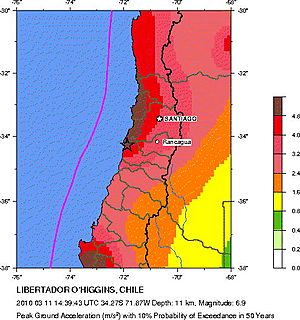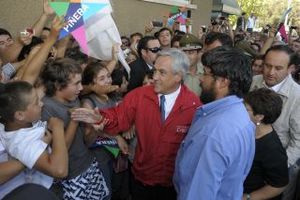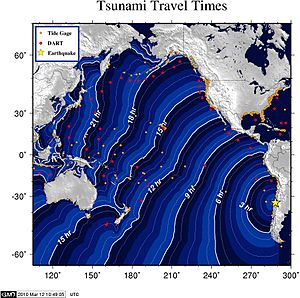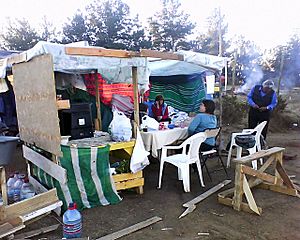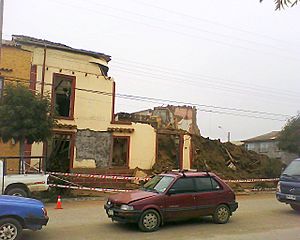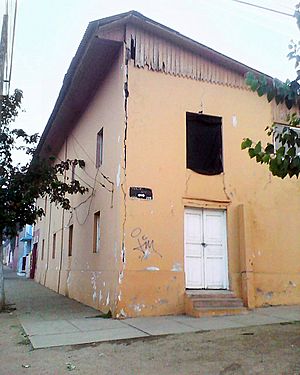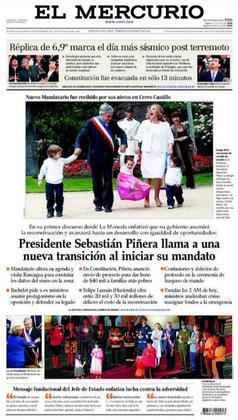2010 Pichilemu earthquakes facts for kids
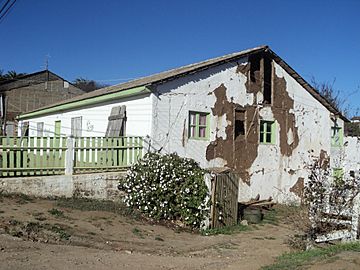
Above: House damaged by the Pichilemu earthquakes, in the epicentre town, as seen on 16 April 2011. Below: Shakemap for the first of the Pichilemu earthquakes produced by the United States Geological Survey
|
|
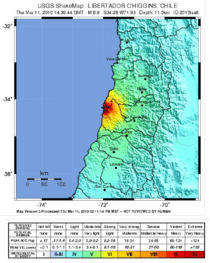 |
|
| UTC time | 2010-03-11 14:39:43 |
|---|---|
| 2010-03-11 14:55:27 | |
| ISC event | 14554049 |
| 14400686 | |
| USGS-ANSS | ComCat |
| ComCat | |
| Local date | 11 March 2010 |
| Local time | 11:39 UTC-3 |
| 11:55 UTC-3 | |
| Magnitude | 6.9 Mw |
| 7.0 Mw | |
| Depth | 33.1 kilometres (20.6 mi) |
| 31.0 kilometres (19.3 mi) | |
| Epicenter | Pichilemu, Chile 34°18′04″S 72°07′48″W / 34.301°S 72.13°W |
| Areas affected | Chile Argentina |
| Max. intensity | X (Extreme) |
| Peak acceleration | 0.086 g (Curicó, Maule) |
| Tsunami | Yes |
| Casualties | 1 dead |
The 2010 Pichilemu earthquakes (Spanish: Terremoto de Pichilemu de 2010) were two strong earthquakes that hit Chile on March 11, 2010. They happened only about 16 minutes apart. The first earthquake measured 6.9 and the second 7.0 on the moment magnitude scale.
These earthquakes were centered near the city of Pichilemu in Chile's O'Higgins Region. They were caused by extra pressure in the Earth's crust. This pressure built up after a much larger earthquake (magnitude 8.8) hit Chile on February 27, 2010.
There was a chance of small local tsunamis near the earthquake's center. Some small but strong waves were seen in the Pichilemu and Bucalemu areas. Sadly, one person died. Many smaller quakes, called aftershocks, followed right away. This caused people to panic in towns along the coast.
The earthquakes caused a lot of damage in Pichilemu. Two important national buildings, the Agustín Ross Park and the Agustín Ross Cultural Centre, were badly hurt. The nearby villages of La Aguada and Cardonal de Panilonco also saw damage. The city of Rancagua was also affected. Because of this, Chile's President, Sebastián Piñera, declared a state of emergency in the O'Higgins Region.
Contents
Why Earthquakes Happen in Chile
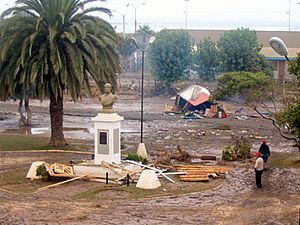
Most of Chile sits on top of a special place where two of Earth's giant plates meet. These plates are like huge pieces of the Earth's outer layer. The Nazca Plate is slowly sliding underneath the South American Plate. This movement happens at about 71 millimeters (about 3 inches) each year.
When these plates move, they can get stuck. When they finally break free, it causes an earthquake. Earthquakes can happen where the plates meet, or within the plates themselves. The area along Chile's coast is known for very powerful earthquakes. The strongest earthquake ever recorded, the 1960 Valdivia earthquake, happened here.
Just two weeks before the Pichilemu earthquakes, on February 27, 2010, a very strong earthquake hit central Chile. It measured 8.8 on the moment magnitude scale. This huge quake happened where the Nazca and South American plates meet, off the coast of the Maule Region. It also caused a tsunami that damaged many coastal towns, including Pichilemu.
Chilean scientists had thought that more energy might be released after the February 27 quake. This was because there hadn't been a very large aftershock (over magnitude 6) right away. Two smaller quakes happened on March 5, just before the Pichilemu earthquakes. These were like warning shakes.
How the Pichilemu Earthquakes Happened
The Pichilemu earthquakes were caused by changes in the stress on the Earth's crust after the big February 27 earthquake. Scientists from the United States Geological Survey (USGS) studied these quakes. They found that the March 11 earthquakes were different from the February 27 one. The February quake happened where the two plates met. The March quakes happened within one of the plates.
Scientists estimated the depth of these earthquakes. The first was about 33.1 kilometers (20.6 miles) deep, and the second was about 31.0 kilometers (19.3 miles) deep.
After the earthquakes, many smaller shakes, called aftershocks, kept happening. Some people worried it was an "earthquake swarm," which is when many quakes happen in one area. But scientists said it was just a lot of aftershocks. More than 50 aftershocks happened in the area soon after the main quakes.
Scientists now think these earthquakes happened along a fault line that was not known before. They call it the Pichilemu Fault. This fault is about 40 kilometers (25 miles) long and 20 kilometers (12 miles) wide. It's about 15 kilometers (9 miles) deep. Geologists believe this fault has been there for millions of years. Its activity just hadn't been noticed until these earthquakes.
In the first six months after the main earthquake, about 10,000 aftershocks were recorded in the Pichilemu area. This shows how much the Earth's crust was still moving and settling.
What Happened Next
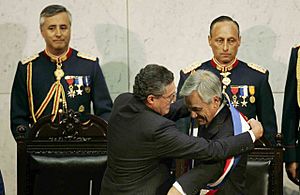
The earthquakes happened just minutes before Chile's new President, Sebastián Piñera, was sworn into office. This ceremony took place in Valparaíso. The shaking was clearly felt there. President Piñera looked worried as he left the palace. The outgoing president, Michelle Bachelet, also looked concerned.
Newspapers reported that some journalists tried to leave the building. The ceremony announcer asked everyone to stay calm. He said the Congress building was strong enough to handle even bigger earthquakes.
Leaders from other countries, like Argentina, Bolivia, Colombia, Ecuador, and Paraguay, were also at the ceremony. The inauguration continued, even though there was a tsunami warning. However, the ceremony finished faster than planned.
President Piñera canceled a special lunch with his guests. He traveled to Rancagua, one of the cities most affected by the earthquakes. He then declared a state of emergency in the O'Higgins Region. This meant the military would help keep order and prevent looting, which had happened after the earlier February quake.
Tsunami Warning and Waves
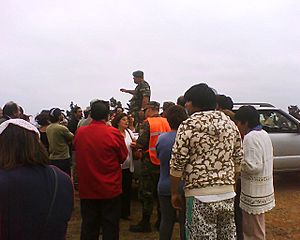
The Pacific Tsunami Warning Center did not issue a warning for the entire Pacific Ocean. But they did say that small local tsunamis were possible within 100 kilometers (62 miles) of the earthquake's center.
About 30 minutes after the first earthquake, the Chilean Navy's Hydrographic and Oceanographic Service issued a tsunami warning. This was to keep people safe from possible new tsunamis. President Piñera told people living near the coast to move to higher ground.
Thousands of people from central Pichilemu went to La Cruz Hill for safety. Some stayed there for several days. Army members helped them. People from the village of Cáhuil also moved to higher ground. The tsunami warning was lifted later that same day.
Reports said that only "small waves" were seen near Pichilemu. The USGS reported a small tsunami with wave heights of 16 centimeters (0.5 feet) in Valparaíso and 29 centimeters (0.95 feet) in San Antonio. However, the Interior Minister reported "violent waves" in Pichilemu and Bucalemu.
Damage and What Happened to People
In Pichilemu, the earthquakes broke the decorative railings around Agustín Ross Park. They also badly damaged the Agustín Ross Cultural Centre, which had just been reopened. The villages of Espinillo and Rodeillo were also affected.
Witnesses said the earthquake came with a "great noise." Many buildings in La Aguada that were already damaged fell down, including the local church. The road to Cardonal de Panilonco was damaged. Many houses made of adobe (a type of mud brick) could not stand the shaking.
Outside Pichilemu, in Rancagua, many homes were severely damaged. A highway overpass collapsed, and part of the main Pan-American highway was damaged. Pichilemu lost power for two days right after the earthquake. Other towns also had partial power outages.
In Santiago, windows rattled, buildings shook, and cell phone service stopped working. An old church in Santiago, which was already damaged from a 1985 earthquake, got even more damaged. In Nilahue Barahona, electric cables fell and caused a fire. This fire burned 65 hectares (about 160 acres) of forest.
The earthquake was also felt in other cities, including Mendoza and Buenos Aires in Argentina, and Montevideo in Uruguay.
Sadly, one person died from a heart attack in Talca, Maule Region, during the earthquakes. Relief efforts for the earlier February earthquake were delayed for about six hours because of the constant aftershocks.
According to a U.S. government agency, the damage from these earthquakes and the small tsunami was "limited." They estimated the damage cost less than one million U.S. dollars.
Aftershocks Continue
After the main 6.9 magnitude earthquake, there were two more strong aftershocks. The first was a magnitude 6.7 quake, which happened 15 minutes later. The second was a magnitude 6.0 quake, which happened 11 minutes after that. In total, there were ten aftershocks within six hours of the first quake.
Almost two months later, on May 2, 2010, another aftershock of magnitude 5.8 hit the O'Higgins Region. It was felt most strongly in Talca. There were no injuries, but some phone lines stopped working. Six more aftershocks hit the Pichilemu area that day.
Another aftershock happened on September 29, 2010, measuring 5.6. It was felt in several regions, and phone lines went down in the O'Higgins Region. No major damage or injuries were reported.
As of February 2013, there had been about 8,500 aftershocks from the Chilean earthquakes of February and March 2010. Most of these happened near Pichilemu. Scientists expect that many more aftershocks will continue to happen for several years.
How the News Reported It
News outlets from Chile and around the world reported on the earthquakes. A local online newspaper called Pichilemu News wrote about the "shaken handover ceremony" of the new president. Another local paper, El Expreso de la Costa, interviewed a scientist who told people in Pichilemu to "try to remain calm, the worst already happened."
The only local radio station that kept broadcasting during the earthquakes was Radio Entre Olas. It used emergency equipment because the power was out. This radio station had also kept broadcasting after the big February 27 earthquake.
National newspapers like El Mercurio and La Tercera featured the earthquakes on their front pages. El Mercurio said the 6.9 magnitude aftershock made it "the most seismic day after the earthquake." La Tercera wrote that President Piñera "faces first crisis as he takes office." Other national papers also covered the event.
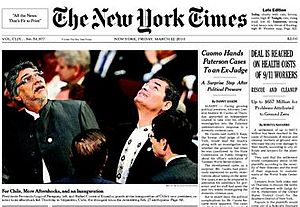
Regional newspapers across Chile also reported on the earthquakes and tsunami warning.
International news outlets like the BBC, CNN, and The Huffington Post also covered the story. The New York Times had a headline that said, "For Chile, More Aftershocks and An Inauguration." They also published a long article explaining how the earthquakes almost overshadowed the new president's swearing-in ceremony. Other major international newspapers also featured the news.
See also
 In Spanish: Terremoto de Pichilemu de 2010 para niños
In Spanish: Terremoto de Pichilemu de 2010 para niños
- 1985 Rapel Lake earthquake
- List of earthquakes in 2010
- List of earthquakes in Chile


